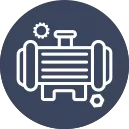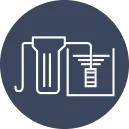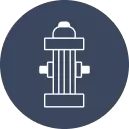This category covers the primary components and specialty items associated with pumping systems. This allows people to look up the right products and see how each specific piece works. Only used in appliances for firefighters, water filtration or as a core pump component, this guide explains the type and use of materials, applications, tips for maintenance and ordering advice.
Hydrants
Hydrants provide easy access to the water networks for firefighting, system cleaning, and maintenance. They connect pipelines to hoses or other equipment with compatible flow and pressure.
- Each outlet on wet barrel hydrants has water above ground level. The outlet valves function independently, so multiple hoses can be used at a time. But they can freeze in cold weather without protection.
- Dry barrel hydrants store water beneath the frost line. Only when the valve underground opens, it fill the barrel. This design avoids freezing in winter, but people must take an additional step before using it.
- Some are standpipe systems that run inside a tall building, and flush hydrants that sit at ground level and in the ground so that they don’t protrude into walkways when not in use.
Filtration & Purification
Some filtration and purification parts keep pumped water or fluids clean and safe. They protect pumps and ensure quality for each job.
- The sediment filter catches sand, silt, and dirt to prevent damage to and clogs within the components of the pump. Carbon filters help the seals last longer and improve the water quality by reducing chlorine, taste and odors from the water.
- Reverse osmosis (RO) units force water through a thin membrane to filter out dissolved salts, metals, and other impurities. This process produces high-quality water for labs, industries, and drinking purposes.
- Ultraviolet (UV) kill bacteria and viruses with light instead of chemicals.. They are also helpful after RO systems or water from a well for additional disinfection.
- Hydraulic chemical injection pumps inject minute volumes of anti-scale agents, biocides, or pH adjusters. These chemicals prevent pumps and pipes from building up and corrosion.
Pump Parts
Pump parts work together to move liquids by converting energy from a motor or driver. Each component has a specific role in this process.
Impellers & Diffusers
The impeller is the part that's spinning inside the pump, and it drives centrifugal force to move the fluid outwards. Its shape (open, closed, semi-open) determines how much head and flow it can produce. Diffusers or volute casings channel the working fluid toward the discharge outlet, converting velocity to pressure and reducing swirl.
Seals & Gaskets
Seals prevent leakages around the rotating shaft. Mechanical seals utilize smooth faces held together under pressure, whilst packing uses a soft material stuffed around the shaft. Gaskets seal spaces between flanges and covers to prevent leaking liquids.
Shafts & Bearings
Pump shafts transfer rotational energy from the motor to the impeller, thus representing its connection. Bearings support and hold the shaft in alignment. They take up the forces acting on the shaft, flexing to resist wobble and wear.
Material Selection
By choosing the right material for each part, people can make sure the pump lasts longer in its environment. Depending on the temperature, pressure and the chemicals that the material is selected for.
- Cast Iron: Durable and economical. Typically used for pump casting in "clean" or low corrosion liquid.
- Stainless Steel: Good resistance to corrosion and high temperatures. Typical for aggressive fluids, food and pharmaceutical applications.
- Brass & Bronze: Because of safety and moderate resistance to corrosion, it is often used for impellers and small fittings in potable water systems.
- Engineered Plastics: These polymers, such as PVC, polypropylene and PVDF, resist many chemicals, have a lighter weight and are better suited for corrosive or acidic fluid handling.
- Elastomers: Parts made of rubber (e.g. EPDM, Viton) in seals and gaskets need to be compatible with the fluid and temperature requirements. Otherwise the components will swell or crack.
Industry Applications
Pump parts and specialty items are utilized within the plans of different businesses. Every industry has different requirements for the flow, pressure, and type of fluid.
- Irrigation & Agriculture: Pumps draw from wells, rivers, or reservoirs to distribute water to fields, greenhouses, and livestock. Filters prevent drips and sprinklers from becoming clogged.
- Municipal & Fire Protection: The hydrants connect firefighting equipment and allow for flushing of the system. Booster stations with large pumps manage the city’s water pressure.
- Industrial Processing: Chemical dosing pumps and corrosion-resistant parts serve petrochemical plants, factories, and water treatment facilities.
- Pool & Spa: Water filtration cartridges, UV disinfection, and chlorination pumps keep residential and commercial pools clear and safe.
Maintenance & Reliability
Regular maintenance improves the lifespan of the pump and prevents breakdowns. A maintenance schedule, on the other hand, not only saves time and money.
- Routine checks should involve visual inspection for leaks, listening for odd noises and feeling for excessive vibration. As specified by the manufacturer, bearings require periodic lubrication, typically with grease every several months or hours of use.
- At regular intervals, usually after the first 200 hours and then every 2,000 hours the oil-lubed models require an oil change. Inspect wear rings, seals, and couplings monthly for wear or damage.
- Availability of spare parts including seals, gaskets and impellers allows for rapid repairs and reduces downtime in case of failure.
Ordering & Inventory
Smart ordering and inventory control mean that users get the right parts at the right time. Purchasing in bulk reduces unit costs and shortens delivery times.
Mistakes are avoided with a clear parts list with SKU numbers and reorder points. There are systems that send alerts when stock drops below an established threshold, so orders can be made early.
Consider mixed-case or pallet quantities for common items to streamline high-volume projects. Flexible pack sizes and drop-shipping options work well for both small contractors and facility managers.
Technical Support & Services
Finding qualified advice and resources assists users in selecting the correct parts and smooth installations.
Technical teams can access the system requirements and recommend the best materials, sizes, and models. The datasheet, CAD drawings, and cross-reference tools provide valuable information to help identify and replace old or obsolete components.
Online tutorials and installation guides help technicians set up and troubleshoot systems. For complicated systems or emergency repairs, onsite service packages deliver all-day support.
Conclusion
Pump Parts & Specialty addresses hydrants, filtration and purification items, core pump components, material choices, specialty pump applications, maintenance practices, ordering strategies and support services. Through segmentation by section, users will understand how to choose the advisable products, plan for sustained success outcomes, and ensure the operational flow of their systems.


